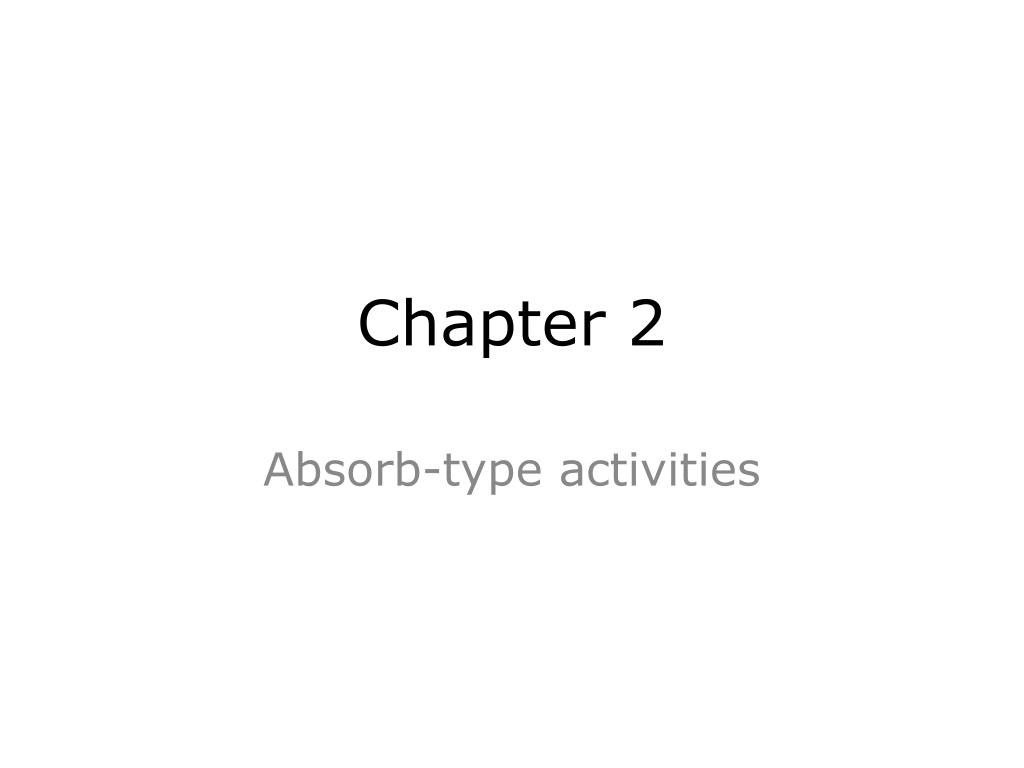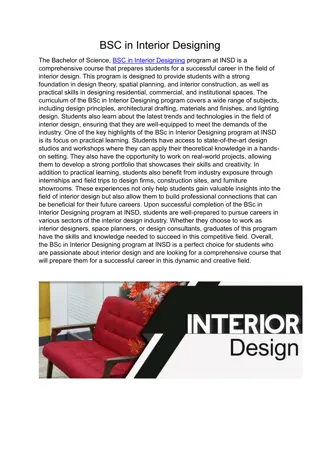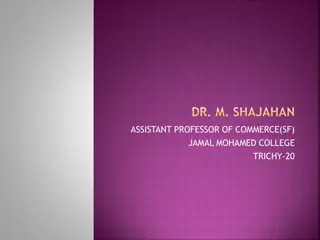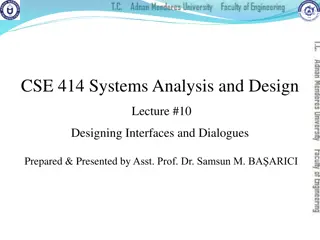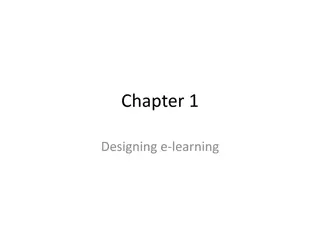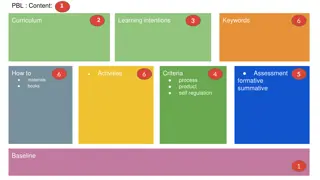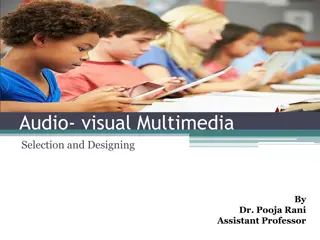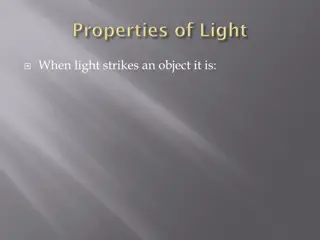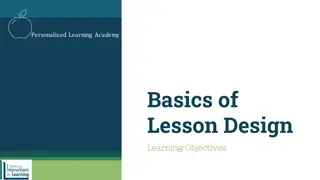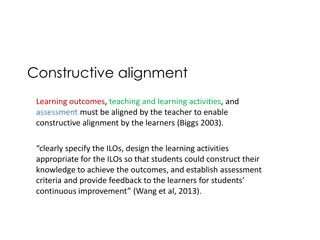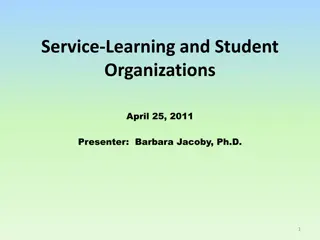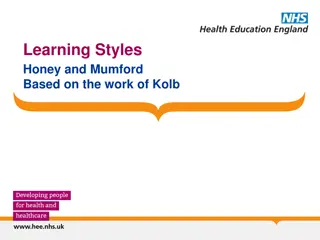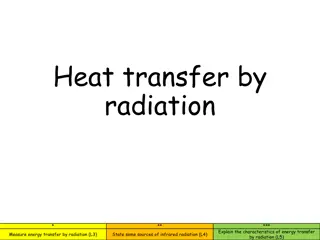Designing Absorb Activities for Effective Learning
Explore the types and best practices of absorb activities, such as presentations, readings, stories, and field trips, to enhance learners' knowledge and skills. Discover how and when to use absorb activities, along with tips for presentations, slide shows, physical demonstrations, and software demonstrations. Engage learners effectively through various absorb activities in your teaching projects.
Download Presentation

Please find below an Image/Link to download the presentation.
The content on the website is provided AS IS for your information and personal use only. It may not be sold, licensed, or shared on other websites without obtaining consent from the author. Download presentation by click this link. If you encounter any issues during the download, it is possible that the publisher has removed the file from their server.
E N D
Presentation Transcript
Chapter 2 Absorb-type activities
Reminder In your project you are asked to design a variety (Absorb, Do, and Connect) activities. This chapters show you examples of Absorb activities.
Types of Absorb Activities 1. Presentations 2. Readings 3. Stories by a teacher 4. Field trips
When to use absorb activity? Absorb activities are not inherently interesting Learners need an introduction To extent current knowledge and skills (new versions, new software) To prepare for Do and Connect activities Best for highly motivated learners
Types of presentations Slide shows Physical demonstrations (repairing, kicking, performing) Software demonstration Informational films (instructional video) Dramas Discussion Presentations
How to use slide shows Communicate visually (convert paragraphs to picture, tables, lists, illustrations instead of bullet points)- Silent movie Narrate clearly ( provide transcripts as well) Animate graphics (to tell a story or show a process) Follow visual principles (no cluttered screens)
How to do physical demonstration Preview the action (preparation, rehearsal) Use close-ups (magnifier- if needed use Elmo) Move smoothly Keep it short Let learners control ( let them pause you online or if recorded let them re-play pause)
Software demonstrations Could be used in standalone e- learning or in live demonstrations in f2f classes.
Types of software demonstration Scenario demonstration (make a multiple choice question with Zebrazapps) User-interface tours (explain the icons and windows) Feature demonstration (what could be done with each button)
How to use software demonstration Introduce the demonstration (what will gain) keep it simple and to the point Clarify this is not a software simulation Follow it with a simulation Invite learner to follow along Provide a low-bandwidth version
Where to use informational video Cause and effect relationships Chronological sequence Chain of actions or discoveries
Best practices Borrow it if you can Get permission Design for the small screen Beware of bandwidth
Dramas Learners watch a fictional scene among people, to illustrate a situation (e.g., good interview, classroom management, etc.) A drama is the fictional counterpart of informational video It could be live, still images, voice, or video
Best practices Write credible dialog Hire good actors Don t forget the drama (not predictable) Tell a story (with characters, a crisis, and resolution for good or ill)
Discussion Presentation When a speech is too boring you may use discussion/debate presentation Helps elicit valuable information and opinions from experts
Types of discussion presentations News interviews Talk-show interviews Debates Panel discussion Mock trials
Best practices for presentations Give learners control path and pace of presentation Reading along while listening will help?? Supply many examples (not simply theories) Provide immediate practice Augment your presentation (create navigation to title, intro, summary) Pick the best mix of media Keep learners active Borrow (pre made presentations)
Readings Sometimes the best e-learning is a good book.. or a good e-book Reading may be a more active learning experience than some learning games especially as learner skims, peruses, reads, imagines, compares, re-reads, jots notes, makes bookmarks, and reflects.
A Big Misconception https://www.youtube.com/watch?v= MOXQo7nURs0
When to use reading activities Learners need deeper knowledge You don t have time to develop more interactive materials Well-written documents are readily available Learners are skillful readers Learners are motivated enough to read on their own
Types of readings Individual documents Libraries of documents to select from (link to docs) Predefined searches to find internet resources Don t forget to include standard references such as Bible, constitution, classic books etc.
Internet Resources Link to Internet resources Provide specific search terms Sources of useful documents scholar.google.com http://academic.research.microsoft.com http://books.google.com www.gutenberg.org books24x7.com
Best practices for reading activities Grow your library gradually Publish a usage policy Simplify obtaining documents Link to publisher s sale site Link to Amazon, Barnes& Noble Set up your own bookstore Buy limited electronic rights JUST for your students Provide documents in multiple formats Provide active (interactive) examples
Stories by a teacher Stories by a teacher is an Absorb activity but stories by students are Connect activity.
Types of stories Hero stories Love stories Disaster stories Tragedies Discovery stories
Best practices for stories by a teacher Tell effective stories The story is credible, important, short and focused, dramatic, tell about something that students care about, tell with emotion, the moral is clear Polish the telling Coach storytellers, casual language, good voice and high sound quality (if online), repeat and rehearse Develop the story Show the face of the storyteller, illustrate the story, spread a single complex story throughout a lesson
Field trips Students may tour an online presentation of a farm, an exhibit, a museum, a monument, or a historical town.
When to use it? Use it when you don t have time or budget to do a real field trip Show how concepts taught in the course are applied (or misapplied) in real world Provide access to concrete examples Reveal examples in context (food chain) Orient learners in a new environment Encourage discovery of patterns
Types of field trips Guided tours Museums
Examples of guided tours Personal travel diaries (with pictures) Web tours (screen casting) Tours of imaginary worlds The human body An imaginary town A cave The atom
Best practices Let learners click, zoom, rotate, and focus Tell them where to pause, notice, or focus Show spatial relationships (overlap stops so they can see next stop) Encourage self exploration Make side excursions safe (they can come back and rejoin tour) Anchor each stop with a visual Keep the tour focused
Virtual museums Other names: web-based museums, e-museums, virtual galleries, online museums, and online galleries.
Best practices for field trips Require learning (not just fun) Include variety of media Tell what is important (why take chances?) Annotate exhibits thoroughly (15 details) Let learners inspect items in detail Help them to download what they want
